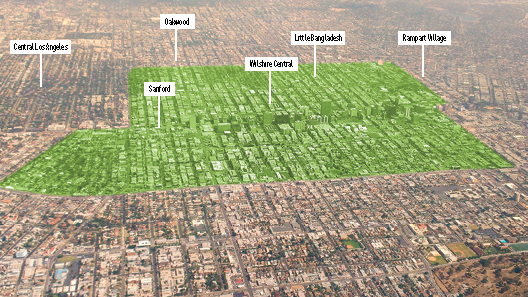Buyer and property profiles for gentrifying, ethnic, retirement and unfamiliar neighborhoods.
 Gentrifying
Gentrifying
In the neighborhoods around the Five Points district in Huntsville, Alabama, homebuyers are a mix of investors and young couples, both with vision. Lea Ellison, CRS, says this area is just beginning its gentrification arc.
The lots are small, and many of the houses were originally just two bedrooms, a kitchen and a living room. Many have additions that may or may not have made sense, and few have garages.
Her do-it-yourself clients want rock-bottom prices. They are willing to do the work because the upside potential is there, she says.
Similarly, in the village of Florence in Northampton, Massachusetts, the housing stock is mainly small farmhouse-style houses with three bedrooms and one to two baths. Craig Della Penna, CRS, associate broker with The Murphys REALTORS® in Northampton, sees a lot of families with young children moving to the area, which was the site of an industrial sewing machine factory. Like the housing around Five Points, renovation is the name of the game in Florence, which attracts a self-selecting group who have vision and can deal with the inevitable chaos renovation brings.
However, a contingent of buyers wants to live in these historic areas but skip the renovations. Recently updated houses in both Florence and in areas adjacent to Five Points sell very quickly for increasing prices. If its completely turnkey and in the village center, we will see 100 people at open houses and multiple offers within a week, Della Penna says. Ellison says theres a waiting list of buyers for renovated houses in the area around downtown Huntsville.
In Sister Bay, Wisconsin, MaryKay Shumway, CRS, is seeing more year-round residents, from young families to retirees, but the weekender contingent is still strong. Many of her clients live in Northern Illinois or Green Bay, Wisconsin, and have discovered Sister Bay as a great getaway.
Sister Bay is far enough away to feel like a different world, but you can hop in the car after work on Friday and come home Sunday afternoon, and still get a few things done, she says.

Sister Bay, Wisconsin, though traditionally a resort town, is seeing an increase in year-round residents, leading to congestion during peak vacation seasons.
 Ethnic
Ethnic
The main reason agents must treat neighborhoods that have ethnic or cultural reputations with a little extra care is the Fair Housing Act, which is very specific in how agents canand more often cannottalk about an areas populace. The act is intended to provide equal access to housing for all people regardless of their race, color, religion, sex, national origin, disability and/or familial status (whether or not someone has children). One of the goals in its establishment is to create more diverse neighborhoods, so it specifically bars steering or guiding clients to or away from certain areas based on these types of characteristics, especially the racial makeup of residents. That really means agents cannot discuss the ethnic makeup of an area with their clients, even if they are asked.
For decades, white households have constituted the majority of households in the U.S. Those mostly-white neighborhoods have become slightly more diverse over the past 30 years.
Furthermore, supplying ethnic-related information about a neighborhood violates the National Association of REALTORS® code of ethics, Duties to the Public, Standard of Practice 10-1, which clearly prohibits volunteering information regarding the racial, religious or ethnic composition of any neighborhood.
Putting Out the Welcome Mat
The Fair Housing Act is a United States federal act intended to protect a homebuyer and renter from seller or landlord discrimination. The law makes it illegal to discriminate in housing transactions, including rentals, sales, lending and insurance, because of a persons race, color, religion, sex, handicap, familial status or national origin.
Home sellers, landlords and seekers, as well as real estate professionals, all have rights and responsibilities under the Fair Housing Act.
Look beneath the legalese, and the act comes down to the fact that all people in America have a right to the roof they want over their headswithout outside influences, preferences, prejudices or stereotypes being imposed.
In addition, the Fair Housing Act is meant to foster welcoming and thriving neighborhoods where diversity is a source of pride.
A home seller or landlord may not discriminate in the sale, rental and financing of property on the basis of race, color, religion, sex, handicap, familial status or national origin.
A home seeker has the right to expect that housing will be available without discrimination or other limitations based on race, color, religion, sex, handicap, familial status or national origin. This includes the right to expect:
- Housing in the requested price range
- A broad range of housing choices
- No discriminatory limitations on communities or locations
- Non-discriminatory terms and conditions for the sale, rental, financing or insuring of a dwelling
- Reasonable accommodations in rules, practices and procedures, if handicapped
- Freedom from harassment or intimidation for exercising fair housing rights.
A real estate professional is prohibited by law from discriminating on the basis of race, color, religion, sex, handicap, familial status or national origin. In addition, real estate professionals cannot honor a home seller or landlords request to discriminate in the terms or conditions of a purchase or rental; deny that housing is available; or advertise that the property is available only to persons of a certain race, color, religion, sex, handicap, familial status or national origin.
Learn more about the Fair Housing Acts design and requirements. If you have specific questions, search Fair Housing Assistance Program, and you will find a contact list for state organizations that offer live assistance.
Neighborhood Watch: Koreatown, Los Angeles

Koreatown, Los Angeles
Koreatown (shown above in green) is the most densely-populated district by population in Los Angeles County, with some 120,000 residents in 2.7 square miles. The neighborhood is large enough to incorporate separate ethnic neighborhoods within it, including Little Bangladesh. Rather than speaking directly to Koreatowns diversity, Wendy Furth, CRS, broker and owner of Furth & Associates in Encino, California, markets it as a commuters community, thanks to its proximity to downtown. By drawing focus to a neighborhoods varied amenities, agents can open up clients to new places to live while honoring the spirit of the Fair Housing Act by respecting everything an area has to offer. If the client likes the look of the houses and the feel of the community, then were in the right neighborhood. The client is home, Furth says.

Parade performers during the Korean Festival

The historic Chapman Park Market Building in the Mid-Wilshire district
 Retirement
Retirement
Those looking at retirement communities are typically senior buyers of the baby boomer generation (age 5170) or older, who are looking to downsize and/or change location for a variety of reasons. These senior buyers tend to seek out a REALTOR® who is an expert at selling to older clients/retirees because they like to work with someone who understands the type of buyer they are and knows what theyre looking for. Earning the Seniors Real Estate Specialists (SRES) designation from the National Association of REALTORS® is certainly a good idea, suggests Lisa Weissgarber Harder, CRS. If you can tell prospects you sold another property in the area to a retiree, that also helps cement the deal. They like that you can give them information about other people who are like them and how they fit into the neighborhood, she adds.
After 39 years selling real estate, Susanne McInerney, CRS, of RE/MAX Leading Edge in Newton, Massachusetts, noticed she had increasingly sold more homes for older clients. She had the SRES designation, but says that wasnt enough to make her feel equipped to serve senior buyers at a higher level. Last fall she earned the more rigorous Certified Senior Housing Professional (CSHP) designation from the Seniors Real Estate Institute. The course work included considerable field time to learn about different types of senior communities. Since earning the CSHP designation last fall, her business with seniors has more than doubled.
When asked at what age they expect to retire, working Americans keep upping their answers. Here are their not-so-great expectations:
There is a separate market for older retirees (typically age 70 and up) who intend to make one last move. They reach the point where they cant take care of their home anymore, says Denise ONeil, CRS. ONeil says dealing with these older seniors takes a greater commitment of time and more handholding. She almost never meets them at the property because most clients no longer drive. I will go to the house, pick up the client and walk them to the car, she says. A longer time frame is involved because the whole process is slower.
 Unfamiliar
Unfamiliar

Mill Pond Park in Menomonee Falls, Wisconsin, where Pat Tasker, CRS, relocated after 20 years in Milwaukee, about 20 miles southeast.
Understanding trends in new markets is essential, says Betsy Pepine, CRS, broker-owner of Pepine Realty in Gainesville, Florida. She finds the BrokerMetrics platform to be useful for analyzing MLS data, and getting involved with homeowners associationsattending meetings if possiblegives insights into various neighborhoods strengths and challenges. Pepine says its essential to analyze at least three or four years of data for a new neighborhood to really get a feel for trends. Ideally, the neighborhood will have a 5 to 8 percent annual turnover, which gives a steady flow of inventory, but doesnt indicate people are leaving the neighborhood en masse, she explains.
After 20 years in Milwaukee, Pat Tasker, CRS, with Shorewest REALTORS® in Menomonee Falls, Wisconsin, was queen of the market. But her clients were typically first-time buyers at low price points who needed a lot of hand-holding, she says. It was labor-intensive work, and she was ready for a change. After the recession, the market was less safe and harder to sell than ever. She decided it was time to focus closer to home and began working at her current office in Menomonee Falls.
While living in the area gave her credibility, she still needed to do her homework. She used the same plan she employed in her urban market and immersed herself in researching market values and selling patterns. She toured open houses to get a better feel for neighborhoods. She even took notice of the people around her. Would she need to dress differently or modify her service based on the expectations of a more affluent clientele?
It was a whole different market of higher education, higher income and more competition from other agents, she says.








